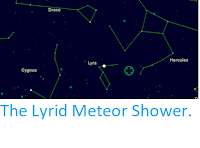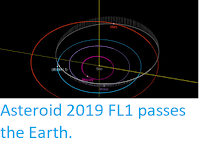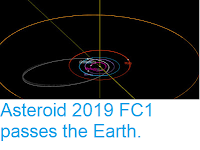Asteroid 2019 GT19 passed by the Earth at a distance of about 805 100
km (2.09 times the average distance between the Earth and the Moon, or
0.54% of the distance between the Earth and the Sun), at about 3.15 am
GMT on Thursday 11 April 2019. There was no danger of
the asteroid hitting us, though were it to do so it would not have
presented a significant threat. 2019 GT19 has an estimated
equivalent
diameter of 5-19 m (i.e. it is estimated that a spherical object
with
the same volume would be 5-19 m in diameter), and an object of this
size
would be expected to explode in
an airburst (an explosion caused by superheating from friction with the
Earth's atmosphere, which is greater than that caused by simply
falling, due to the orbital momentum of the asteroid) in the atmosphere
between 40 and 23 km above the ground, with only fragmentary material
reaching the Earth's surface.
Short clip showing image of 2019 GT19 captured on 12 April from the Siding Spring Observatory in Australia. The moving object is the asteroid, the elongate objects are stars; each frame is made up of a composite of several images with the camera moving between frames to keep the stars in the same position. Japan Space Agency.
2019 GT19 was discovered on 12 April 2019 (the day after its closest approach to the Earth) by the Japan Space Agency's Janess-G 0.25 m telescope at Siding Spring Observatory in Australia. The
designation 2019 GT19 implies that it was the 475th asteroid (asteroid T19 -
in numbering asteroids the letters A-Y, excluding I, are assigned
numbers from 1 to 24, with a number added to the end each time the
alphabet is ended, so that A = 1, A1 = 25, A2 = 49, etc., which means that T19 = 19 + (24 X 19) = 4755)
discovered in the first half of April 2019 (period 2019 G).
The position and calculated orbit of 2019 GT19. JPL Small Body Database.
2019 GT19 is
calculated to have
an 526 day orbital period and an eccentric orbit
tilted at an angle of 7.76° to the plane of the Solar System, which
takes it from 0.80 AU from the Sun (i.e. 80% of the the average distance
at
which the Earth orbits the Sun) to 1.74 AU from the Sun (i.e. 174% of
the
average distance at which the Earth orbits the Sun, more than the
distance at which the planet Mars orbits). It is therefore
classed as an
Apollo Group Asteroid (an asteroid that is on average further from the
Sun than the Earth, but which does get closer). This means that close
encounters between the asteroid and the Earth are quite common, with the
last calculated to have happened in October 2011 and the next predicted
for November 2021.
See also...
Follow Sciency Thoughts on Facebook.








